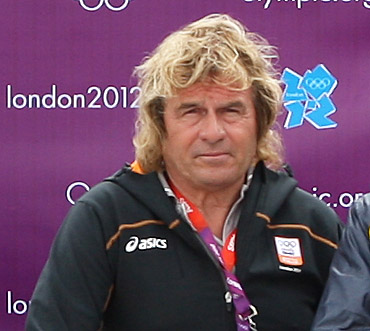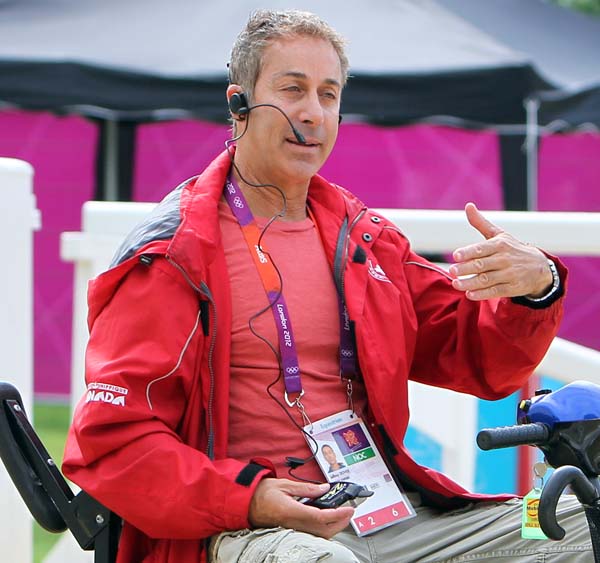Olympic Dressage Team Competition Format Changes Sought
13 years ago StraightArrow Comments Off on Olympic Dressage Team Competition Format Changes Sought

By KENNETH J. BRADDICK
The second straight Olympics to hold dressage teams to three horses and riders with no fourth drop score has led to calls for change from several nations while eventing and jumping squads compete with extra combinations as insurance against injury eliminating countries from team competition.
Coaches of Canada, Denmark, the Netherlands and the United States, also a member of the International Equrstrian Federation (FEI) Dressage Committee that proposes Olympic formats, were unanimous in their criticism of the teams of three members that was in force at the London Games, as it was in the 2008 Beijing Olympics.
Nations that also qualify an individual–in London that was Denmark, Germany, Great Britain, the Netherlands and USA–can substitute the individual pair if a team horse and rider have to scratch.
Canada became a victim of the no-drop score when one of its three combinations was eliminated thus removng the entire squad from the Nations Cup.
The coaches appeared generally in favor of the new format of two competitions for the team medals, but the gap of four days between the Aug. 2-3 Grand Prix and the Grand Prix Special on Aug. 7 drew sharp criticism for the competition losing momentum and financially penalizing dressage fans many of whom faced steep hotel and restaurant bills.
“This (no drop score) drives us further away from other disciplines,” said Sjef Janssen, the Netherlands’ national coach whose team won bronze. “Why do we have to be different. I think it is good for the outside world that we have one face, one opinion on the competition formula.
“My feeling is that dressage got kicked in the butt.”
“I always thought we should have four riders and horses when it was changed before 2008,” said Anne Gribbons, the U.S. coach who is also one of the six members of the FEI Dressage Committee.

“The only reason there was not an uproar over this issue was that it happened to Canada. If it had happened to one of the top teams we would be hearing about it.
“Dressage is as popular if not more so than the other disciplines, every seat was sold. Horses come from all round the world. What’s the message we send when the eventers get five horses and the jumpers four?”
Of the 200 rider and horse combinations in Olympic equestrian events this year, dressage had a total of 50 while eventing and jumping each had 75. For the first time, dressage had broader geographic representation than eventing with riders from 23 nations compared with 22 for eventing.
The competition schedule for eventing was uninterrupted with two days of dressage, one day of cross country and the final jumping phase in which both team and individual medals were decided from July 28 through July 31.
Jumping began Aug. 4 with a speed competition to qualify for the first round, second qualifier on Aug. 5 and third qualifier Aug. 6 when team medals were also decided. A one-day break was scheduled for Aug. 7 and the individual final was staged Aug. 8.
The Grand Prix was the first phase of dressage team competition Aug. 2-3 and then a break until the Grand Prix Special second phase of the team competition on Aug. 7. A break on Aug. 8 then the Individual medal final of the musical freestyle on Aug. 9.
The Dressage Task Force that was created after the 2008 Olympics to overhaul the sport addressed the issue of four-member teams to allow a drop score, and proposed that nations qualifying a team should have three members with a fourth combination riding as an indnvidual that could also act as a substitute for a team if necessary.
Although it means no drop score, this format would “make the sport more understandable (and) this system is very much preferred by TV and visitors without detailed knowledge of the sport.” The task force proposed increasing the number of athletes to 60 from 50 to implement the proposal.
“This will enable the universality of the dressage element of the equestrian Olympics to be maintained whilst ensuring that the best riders in the world are represented,” it proposed, and “there is also the chance that the additional rider can outperform one of the team members and go on to compete in the individual final.
“Increasing the number of dressage athletes would mean a better geographical spread and maintain the ability of developing countries to compete, and would also create greater equity between the disciplines in terms of overall numbers.”
The competition schedule proposed days one and two for the Grand Prix first phase of the team and individual test open to all 60 athletes, day three for the Grand Prix Special final team competition open to 40 athletes of the eight best teams and 16 best individuals, and day four musical freestyle individual final with the best 20 athletes.
This format did not make it through talks between the FEI and the International Olympic Committee, though eventing with five riders and jumping with four did.
Trond Asmyr, FEI Dressage Director, said this was the first time the format was used in an Olympics “and it will be reviewed based on the experiences from London.”
Robert Dover, who was a coach of a Canadian and a member of the task force that drew up the original format, said he believed that should be adopted for the next Olympics in Rio de Janeiro in 2016.

Denmark coach Rudolf Zeillinger said he accepted that the two-phase team competition made the competition more interesting for TV but there were too many days between the Grand Prix and the Special.
“I think it’s good to have a fourth rider if teams travel so far,” he said. “It should be fair for all teams, and with three it makes it a little more tight.”
Anne Gribbons, the U.S. team coach and FEI Dressage Committee member representing judges, described as “significant” the break between the two phases of the team competition that “was exhausting” for the riders, though it probably had no effect on the horses.
“Three days waiting between the two team competition was difficult for many people,” she said, “especially those who really love and understand the sport because money of them do not have the money to wait around.”
Like some others she complained about the draw for the Grand Prix Special.
“It was completely crazy,” she said. Three riders on teams not in medal position, such as Spain, Sweden and the USA, were scheduled to ride within a period of about an hour, meaning warmups were rushed and inadequate, which she said was “incredible” at an Olympics.
“It dumped on Steffen Peters and Ravel and Patrik Kittel and Scandic. That doesn’t work in real life.”
Sjef Janssen said that the riders and trainers were always against teams of three riders.
But one of his biggest concerns is the “totally outdated way judges perform compared witb other Olympic sports.”
Other sports have developed a written “Bible” that everyone can access as to how each and every movement should be performed and is judged.
“We have nothing to hold on to,” he said. “It gives the judges too much gray areas where everybody can interpret it the way they want to.
“Otherwise it could become like ice skating at the Olympics in Salt Lake City. We will be in deep trouble. We must make judging more modern or get kicked out of the Olympics, maybe even sooner than we think. We are in a danger zone.”


